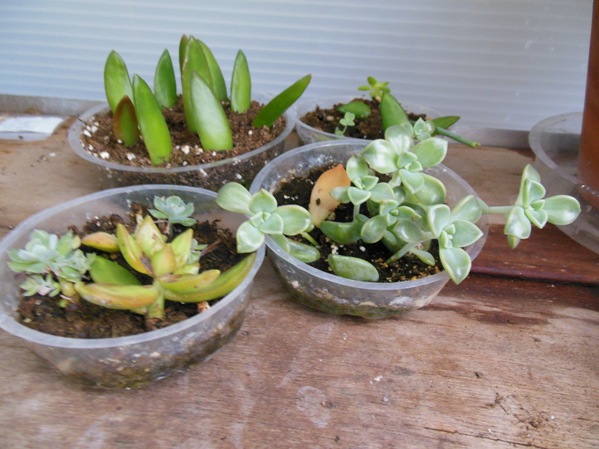
For years I was a snob towards succulents. I thought they were beneath me as a gardener; after all, anyone can grow a succulent. In my mind I thought there was no skill needed to grow this type of plant. I found their appearance to be dull and just a blah shade of green but slowly these notions began to change. I discovered succulents are often on clearance racks for $1 or less, which was definitely in my price range. After having succulents in my greenhouse they made their way into containers and hanging baskets. It was here my succulent craze really began because a cascading succulent in a hanging basket looked amazing and I had to have more of them!
My budget was still tight with not a lot of money available for new plants so I continued to scour clearance racks. Then it dawned on me that I could probably propagate some new plants. It seemed that each time I bumped a succulent several leaves fell to the ground. So on a whim I took these leaves and stuck them in some old potting soil and in time they started to grow. Now my greenhouse is polluted with succulent propagations. I can’t seem to resist growing a free plant, and it gives me an easy winter time gardening project in the greenhouse.
I have experimented with several different containers for planting the broken leaves and my favorite is a 4” clear plastic saucer normally used to hold water under a flower pot. A normal container will also work, but it wastes a lot of potting soil. The 4” saucer is very shallow and small, which seems to fit the petite size of a succulent leaf. I fill the saucer with soil to the top of the rim and simply stick the succulent leaves into the soil. Then I water which compacts the soil.
As with a mature succulent plant, the leaves do not like a lot of water. My saucers are meant to catch water, so there are no drainage holes for the leaves. I have killed a few batches of propagations from over watering and have learned to only add water when the soil is dry. A light watering is all you need with just enough moisture to dampen the soil.
When compared to a geranium or coleus propagation, succulents are slow starters. It can easily take a month to see the first new leaves, but just be patient. Warm temperatures, light watering and daylight will produce new leaves in time. Most succulent species, when propagated, will start to grow the end of the stem first. This is a cluster of leaves that resembles a rosette. The rosette will continue to grow and more stem and leaves will form behind it creating the cascading succulent.
When the new plant has reached 1-3” in length I typically repot it. A gentle tug will release the plant from the saucer and you can repot it into a small container of its own. This is when the plant will gain speed and steadily grow larger. By spring you will have a new plant that was not purchased at a store. The new succulents can be added into containers, succulent gardens and hanging baskets for year round color and texture inside the greenhouse.
Lyndsey Roth is an experienced gardener and greenhouse grower.
Related Articles & Free Email Newsletter
Increasing the Lifespan of a Succulent Plant
Plant Propagation Calendar – What You Should Be Doing Each Month of the Year




Comment here